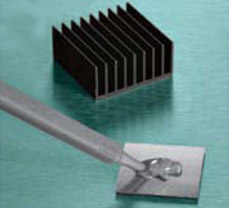Long-term, reliable protection of sensitive circuits and components is important in many of today’s delicate and demanding electronic applications. With the increase in processing power and the trend toward smaller, more compact electronic modules, the need for thermal management is growing. Dow’s family of thermally conductive materials provides excellent thermal management options. Thermally conductive silicones function as heat transfer media, durable dielectric insulation, barriers against environmental contaminants and as stress-relieving shock and vibration absorbers over a wide temperature and humidity range.
In addition to sustaining their physical and electrical properties over a broad range of operating conditions, silicones are resistant to ozone and ultraviolet degradation and have good chemical stability. Dow’s line of thermal management materials includes adhesives, encapsulants, compounds and gels.
Good heat transfer is dependent on a good interface between the heat producing device and the heat transfer media. Silicones have a low surface tension that enables them to wet most surfaces, which can lower the thermal contact resistance between the substrate and the material.
| Items |
SE4422 Adhesive Dow Electronics Thermally Conductive Adhesives/Sealants |
SE9184 CV Adhesive Dow Electronics Thermally Conductive Adhesives/Sealants |
SE4450 Adhesive Dow Electronics Thermally Conductive Adhesives/Sealants |
1-4173 Adhesive Dow Electronics Thermally Conductive Adhesives/Sealants |
1-4174 Adhesive Dow Electronics Thermally Conductive Adhesives/Sealants |
|||||
| Type | N/A Thermally Conductive Adhesives | |||||||||
| Product Form | N/A One-Part | |||||||||
| Color | N/A Gray | N/A White | N/A Gray | N/A Gray | N/A Gray | |||||
| Viscosity | N/A 200000 mPa/s | N/A Non-flow | N/A 61000 mPa/s | N/A 58000 mPa/s | N/A 58000 mPa/s | |||||
| Durometer | N/A 69 A | N/A 72 A | N/A 95 A | N/A 92 A | N/A 92 A | |||||
| Penetration (1/10 of mm) | N/A | |||||||||
| Tensile Strength | N/A 754 psi5.2 MPa53 kgf/cm² | N/A 421 psi2.9 MPa29.6 kgf/cm² | N/A 1044 psi7.2 MPa73.4 kgf/cm² | N/A 900 psi6.2 MPa63.3 kgf/cm² | N/A 900 psi6.2 MPa63.3 kgf/cm² | |||||
| Elongation | N/A 120 % | N/A 70 % | N/A 40 % | N/A 20 % | N/A | |||||
| Specific Gravity | N/A 2.17 | N/A | N/A 2.74 | N/A 2.7 | N/A 2.71 | |||||
| Compression Modulus at 10 % | N/A | |||||||||
| Linear CTE | N/A 203 µ/mC | N/A | N/A | N/A 126 µ/mC | N/A | |||||
| Working Time at Room Temperature1 | N/A < 10 min | N/A | N/A | N/A | N/A | |||||
| Room Temperature Cure Time2 | N/A 144 h | N/A 48 h | N/A | N/A | N/A | |||||
| Heat Cure Time at 100 ºC (212 ºF)3 | N/A | N/A | N/A | N/A 90 min | N/A 90 min | |||||
| Heat Cure Time at 120 ºC | N/A | |||||||||
| Heat Cure Time at 125 ºC (257 ºF)4 | N/A | N/A | N/A | N/A 30 min | N/A 30 min | |||||
| Heat Cure Time at 150 ºC (302 ºF)5 | N/A | N/A | N/A 30 min | N/A 20 min | N/A 20 min | |||||
| Unprimed Adhesion Lap Shear | N/A 230 psi160 N/cm²16 kgf/cm² | N/A 300 psi205 N/cm²21 kgf/cm² | N/A 530 psi365 N/cm²37 kgf/cm² | N/A 640 psi440 N/cm²45 kgf/cm² | N/A 590 psi405 N/cm²41 kgf/cm² | |||||
| Thermal Conductivity6 | N/A 0.9 W/m·K | N/A 0.84 W/m·K | N/A 1.97 W/m·K | N/A 1.9 W/m·K | N/A 1.9 W/m·K | |||||
| Shelf Life from Date of Manufacture | N/A 9 months | N/A 7 months | N/A 6 months | N/A 6 months at 5 ºC | N/A 6 months at 5 ºC | |||||
| Dielectric Strength | N/A 365 V/mil14.3 kV/mm | N/A 508 V/mil20 kV/mm | N/A 610 V/mil24 kV/mm | N/A 425 V/mil16.7 kV/mm | N/A 425 V/mil16.7 kV/mm | |||||
| Dielectric Constant at 100 Hz | N/A 4.44 | N/A | N/A | N/A 4.98 | N/A | |||||
| Dielectric Constant at 1 kHz | N/A | |||||||||
| Dielectric Constant at 100 kHz | N/A 4.38 | N/A | N/A | N/A 4.86 | N/A 4.63 | |||||
| Dielectric Constant at 1 MHz | N/A 4.9 | N/A 3.9 | N/A 4.7 | N/A | N/A | |||||
| Dissipation Factor at 100 Hz | N/A 0.00498 | N/A | N/A | N/A 0.008 | N/A | |||||
| Dissipation Factor at 1 kHz | N/A | |||||||||
| Dissipation Factor at 100 kHz | N/A 0.00498 | N/A | N/A | N/A < 0.003 | N/A 0.0021 | |||||
| Dissipation Factor at 1 MHz | N/A 0.006 | N/A 0.002 | N/A 0.002 | N/A | N/A | |||||
| Volume Resistivity | N/A 5.00E+15 O/cm | N/A 1.00E+15 O/cm | N/A 2.00E+15 O/cm | N/A 2.20E+14 O/cm | N/A 1.90E+14 O/cm | |||||
|
||||||||||
Robert McKeown offers a variety of adhesive and sealant products for a wide range of commercial and industrial applications. Our silicone epoxy adhesives and sealants, in particular, are ideal for applications such as:
FEATURES AND USES OF ELECTRONICS SEALANTS AND ADHESIVES
Providing ultimate reliability and longevity, our electronics adhesives and sealants can be used to form bonds to many different surfaces and substrates, including:
- Ceramics
- Metals
- Glass
- Filled plastics
These specialized solutions eliminate the need for mechanical fastening and clamping while allowing for optimal ease of processing. Reliable and efficient in temperatures ranging from -45 °C to 200 °C, our electronics adhesives and sealants provide excellent dielectric insulation.
Most silicone formulations are solventless, eliminating the need for special storage, ventilation, or handling. And because many of our electronics adhesives and solvents are reworkable, they offer great flexibility and allow for easier module repair.
Electronics adhesives and sealants are frequently used in: automotive, communications, industrial, and energy industries, as well as consumer devices.
Extremely versatile, these adhesives can be used for:
- Sealing lids and housing grooves
- Cushioning or stabilizing fragile components
- Affixing components such as capacitors and coils to circuit boards
- Adhering module lids and baseplates
- Gasketing
SILICONE ADHESIVES
One of the most popular types of electronics adhesives, silicone adhesives provide excellent flexibility and high heat resistance, making them ideal for electrical, automotive, aerospace, and construction industries. There are several varieties of silicone adhesives available, including:
- Two-component systems that require a curing agent
- One-component systems that cure through air moisture
- UV or EB radiation curing adhesives
- Pressure-sensitive versions that adhere to surfaces with little pressure
RTV sealants (room-temperature vulcanizing) begin to cure as soon as they’re exposed to moisture in the air, so they must be used quickly. Pressure-sensitive sealants offer a permanent tackiness. UV- or radiation-cured sealants, on the other hand, require UV light to cure, while thermoset silicone sealants require heat to cure. Although not as strong as other sealants or adhesives, electrical silicone sealants remain flexible even when fully dried or cured. Various types of silicone sealants serve as ideal solutions for high-heat applications like engine gaskets.
In electronics fabrication, silicone adhesive sealants are often used for fixing parts on circuit boards, LCD module assembly, general sealing, and component protection. Specific formulations differ depending on intended use and can be customized to allow for enhanced thermal conductivity, superior protection of metal electrodes, and faster cure times. These sealants are available in chemical-, heat-, mildew-, and oil-resistant formulations to meet a wide range of application needs.
Industrial silicone epoxy is used for:
- General-purpose fixture sealing of tubs
- Windows, ductwork
- Gaskets
- General-purpose bonding
- Sealing
THERMAL SEALANTS
High temperatures often present problems for conventional adhesive materials and can affect printed circuit boards and assemblies. At Robert McKeown, we offer the highest-level special adhesive grades of thermal sealants, which allow for enhanced thermal conductivity. Both low-viscosity liquids and non-slump formations are available in two-cure chemistries.
We also offer one-part moisture-cure grades, which use room-temperature processing to cut back on equipment needs. After cure, the materials form strong but flexible bonds, which protect from mechanical stress and vibration. Both one- and two-part heat-cure solutions accelerate processing and support high throughput production.
Heat resistant silicone adhesives are extremely versatile materials and dispense easily at room temperature, but can also cure quickly at any thickness level at temperatures as low as 90°C. Efficacy and functionality are improved when higher temperatures accelerate cure times.
CHEMICAL RESISTANT ADHESIVES
Chemical resistant silicone adhesives are commonly used in:
- Chemical processing plants
- Chemical piping and tanks
- Medical devices
These adhesives can reliably protect against a wide range of chemicals and harsh materials, including acid, alcohol, and fuel. Depending on specific application requirements, they can also provide resistance against solvents, bases, sterilization, and water.
EPOXY BASED ADHESIVES
Epoxy based adhesives are created by mixing a resin and a hardener. Curing is initiated when the resin is mixed with a certain catalyst. The covalent bonds resulting from this combination determine the rigidity and strength of the epoxy sealant.
Epoxy adhesives can reliably adhere to a variety of materials and are ideal for applications demanding chemical resistance, high strength, and low stress. Thermally conductive, microelectronic-grade, general-purpose, high-temperature and chemical resistant epoxy adhesives are available as both one- and two-part solutions. Epoxy adhesive and sealants allow for room temperature, thermal, or UV-curing capabilities.


